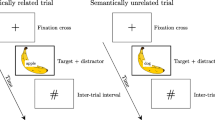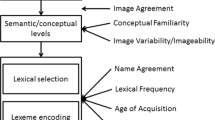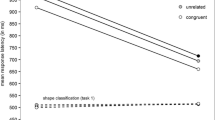Abstract
In the picture-word interference task the naming of a picture is hampered by the presence of a distractor word that is to be ignored. Two main components of this interference effect can be distinguished: an interference effect induced by an unrelated distractor word in comparison with a nonword control, and an additional interference effect that is due to a semantic similarity between target and distractor (calledsemantic interference). We examine whether the size of these two interference effects is affected by the number of different target pictures in an experiment. The results show that both interference effects increase with the size of the target set. This finding has two implications. First, at an empirical level, the use of a relatively small number of target pictures may account for remarkably small, or even nonsignificant, picture-word interference effects in a number of previous studies. Second, at a theoretical level, the present finding is in accordance with a name-retrieval account of picture-word interference.
Similar content being viewed by others
References
Bakan, P., & Alperson, B. (1967). Pronounceability, attensity, and interference in the color-word test.American Journal of Psychology, 80, 416–420.
Brown, W. (1915). Practice in associating color names with colors.Psychological Review, 22, 45–55.
Burke, D. M., MacKay, D. G., Worthley, J. S., Wade, E. (1991). On the tip of the tongue: What causes word finding failures in young and older adults?Journal of Memory and Language, 30, 542–579.
Dalrymple-Alford, E. C., & Budayr, B. (1966). Examination of some aspects of the Stroop color-word test.Perceptual and Motor Skills, 23, 1211–1214.
Dell, G. S., & O'Seaghdha, P. G. (1992). Stages of lexical access in language production.Cognition, 42, 287–314.
Dyer, F. N. (1973). The Stroop phenomenon and its use in the study of perceptual, cognitive, and response processes.Memory & Cognition, 1, 106–120.
Ellis, A. W., & Young, A. W. (1988).Human cognitive neuropsychology. Hillsdale, NJ: Lawrence Erlbaum.
Eriksen, B. A., & Eriksen, C. W. (1974) Effects of noise letters upon the identification of a target letter in an nonsearch task.Perception & Psychophysics, 16, 143–149.
Eriksen, C. W., Coles, M. G. H., Morris, L. R., & O'Hara, W. P. (1985). An electromyographic examination of response competition.Bulletin of the Psychonomic Society, 23, 165–168.
Fox, L. A., Shor, R. E., & Steinman, R. J. (1971). Semantic gradients and interference in naming color, spatial direction, and numerosity.Journal of Experimental Psychology, 91, 59–65.
Fraisse, P. (1964). Le temps de réaction verbale: Dénomination et lecture [Verbal reaction times: Naming and reading].Année psychologique, 64, 21–46.
Glaser, W. R., & Düngelhoff, F.-J. (1984). The time course of picture-word interference.Journal of Experimental Psychology: Human Perception and Performance, 10, 640–654.
Glaser, W. R., & Glaser, M. O. (1989). Context effects on Stroop-like word and picture processing.Journal of Experimental Psychology: General, 118, 13–42.
Gohlson, B., & Hohle, R. H., (1968). Choice reaction times to hues printed in conflicting hue names and nonsense words.Journal of Experimental Psychology, 76, 413–418.
Golden, C. J., (1974). Effect of differing number of colors on the Stroop color and word test.Perceptual and Motor Skills, 39, 550.
Hock, H. S., & Egeth, H. E. (1970). Verbal interference with encoding in a perceptual classification task.Journal of Experimental Psychology, 83, 229–303.
Jescheniak, J. D., & Levelt, W. J. M. (in press). Word frequency effects in speech production: retrieval of syntactic information and of phonological formJournal of Experimental Psychology: Learning, Memory, and Cognition.
Keele, S. W. (1972). Attention demands of memory retrieval.Journal of Experimental Psychology, 93, 245–248.
Klein, G. S. (1964). Semantic power measured through the interference of words with color-naming.American Journal of Psychology, 77, 576–588.
La Heij, W. (1988). Components of Stroop-like interference in picture naming.Memory & Cognition, 16, 400–410.
La Heij, W., de Bruyn, E., Elens, E., Hartsuiker, R., Helaha, D., & van Schelven, L. (1990). Orthographic facilitation and categorical interference in a word-translation variant of the Stroop task.Canadian Journal of Psychology, 44, 76–83.
La Heij, W., Dirkx, J., & Kramer, P. (1990). Categorical interference and associative priming in picture naming.British Journal of Psychology, 81, 511–525.
La Heij, W., Starreveld, P. A., & Steehouwer, L. C. (1993). Semantic interference and orthographic facilitation in definition naming.Journal of Experimental Psychology: Learning, Memory, and Cognition.19, 352–368.
La Heij, W., van der Heijden, A. H. C., & Schreuder, R. (1985). Stroop-like interference in word-naming tasks.Journal of Experimental Psychology: Human Perception and Performance, 11, 62–80.
La Heij, W., & Vermeij, M. (1987). Reading versus naming: The effect of target set size on contextual interference and facilitation. Perception & Psychophysics,41, 355–366.
Levelt, W. J. M. (1992). Accessing words in speech production: Stages, processes and representations.Cognition, 42, 1–22.
Lupker, S. J. (1979). The semantic nature of response competition in the picture-word interference task.Memory & Cognition, 7, 485–495.
McClain, L. (1983). Effects of response type and set size on Stroop color-word performance.Perceptual and Motor Skills, 56, 735–743.
MacLeod, C. M. (1991). Half a century of research on the Stroop effect: An integrative review.Psychological Bulletin, 109, 163–203.
Morton, J. (1969). Interaction of information in word recognition.Psychological Review, 76, 165–178.
Neill, W. T. (1977). Inhibitory and facilitatory processes in selective attention.Journal of Experimental Psychology: Human Perception and Performance, 3, 444–450.
Neumann, O. (1980).Informationsselektion und Handlungssteuerung [Selection of information and control of action]. Unpublished doctoral dissertation, University of Bochum, Germany.
Neumann, O. (1986). Facilitative and inhibitory effects of “semantic relatedness” (Report No. 111/1986). Bielefeld, Federal Republic of Germany: University of Bielefeld, Research Group on “Perception and Action”.
Neumann, O, & Kautz, L. (1982).Semantische Förderung und semantische Interferenz im Benennungsexperiment [Semantic facilitation and semantic interference in a naming experiment]. Report nr. 23/1982, University of Bochum, Germany.
Oldfield, R. C., & Wingfield, A. (1965). Response latencies in naming objects.Quarterly Journal of Experimental Psychology, 17, 273–281.
Proctor, R. W. (1978). Sources of color-word interference in the Stroop color-naming task.Perception & Psychophysics, 23, 413–419.
Proctor, R. W., & Fober, G. W. (1985). Repeated-stimulus superiority and inferiority effects in the identification of letters and digits.Perception & Psychophysics, 38, 125–134.
Ray, C. (1974). The manipulation of color response times in a colorword interference task.Perception & Psychophysics, 16, 101–104.
Rayner, K, & Springer, C. J. (1986). Graphemic and semantic similarity effects in the picture-word interference task.British Journal of Psychology, 77, 207–222.
Riddoch, M. J., & Humphreys, G. W. (1987). Visual object processing in optic aphasia: A case of semantic access agnosia.Cognitive Neuropsychology, 4, 131–185.
Roelofs, A. (1992a). A spreading-activation theory of lemma retrieval in speaking.Cognition, 42, 107–142.
Roelofs, A. (1992b).Lemma retrieval in speaking. Unpublished doctoral dissertation, Catholic University of Nijmegen, The Netherlands.
Roelofs, A. (1993). Testing a non-decompositional theory of lemma retrieval in speaking: retrieval of verbs.Cognition, 47, 59–87.
Rosinski, R. R. (1977). Picture-word interference is semantically based.Child Development, 48, 643–647.
Schriefers, H., Meyer, A. S., & Levelt, W. J. M. (1990). Exploring the time course of lexical access in language production: Picture-word interference studies.Journal of Memory and Language, 29, 86–102.
Seymour, P. H. K. (1977). Conceptual encoding and the locus of the Stroop effect.Quarterly Journal of Experimental Psychology, 29, 245–265.
Starreveld, P. A., & La Heij, W. (in press). Semantic interference, orthographic facilitation and their interaction in naming tasks.Journal of Experimental Psychology: Learning, Memory, and Cognition.
Taylor, D. A. (1977). Time course of context effects.Journal of Experimental Psychology: General, 4, 404–426.
Tipper, S. P. (1985). The negative priming effect: Inhibitory priming by ignored objects.Quarterly Journal of Experimental Psychology, 37A, 571–590.
Underwood, G., & Briggs, P. (1984). The development of word recognition processes.British Journal of Psychology, 75, 243–255.
Vitkovitch, M., & Humphreys, G. W. (1991). Perseverant responding in speeded naming of pictures: It's in the links.Journal of Experimental Psychology: Learning, Memory, and Cognition, 17, 664–680.
Warren, C., & Morton, J. (1982). The effects of priming on picture recognition.British Journal of Psychology, 73, 117–129.
Warren, R. E. (1974). Association, directionality, and stimulus encoding.Journal of Experimental Psychology, 102, 151–158.
Williams, E. (1977). The effects of amount of information in the Stroop color word test.Perception & Psychophysics, 22, 463–470.
Wingfield, A. (1968). Effects of frequency on identification and naming of objects.American Journal of Psychology, 81, 226–234.
Author information
Authors and Affiliations
Corresponding author
Rights and permissions
About this article
Cite this article
La Heij, W., van den Hof, E. Picture-word interference increases with target-set size. Psychol. Res 58, 119–133 (1995). https://doi.org/10.1007/BF00571100
Received:
Accepted:
Issue Date:
DOI: https://doi.org/10.1007/BF00571100




